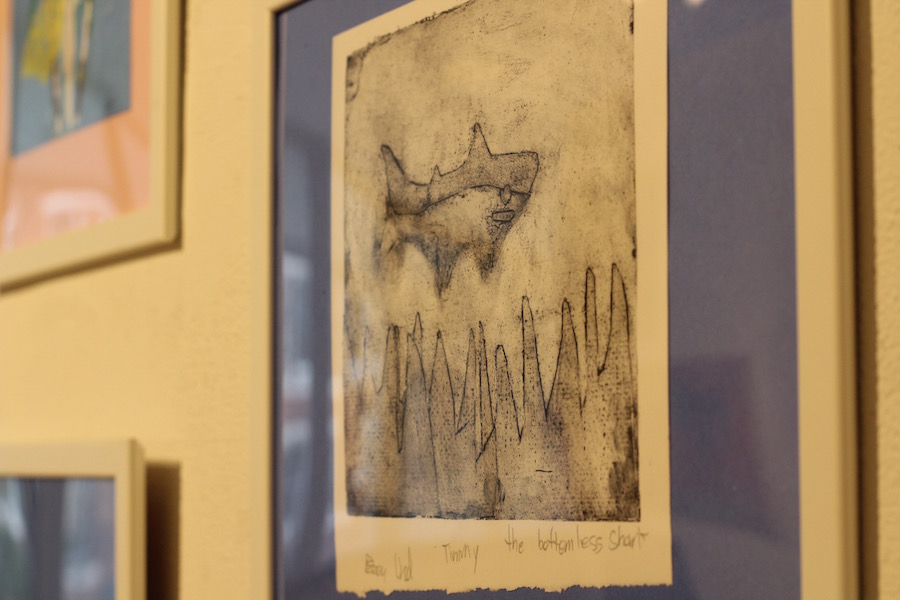
Creative Arts Workshop | Arts, Culture & Community
.jpg)
The table is so unassuming you almost walk past it the first time through. There are a few smudges of blue, a mess of shapes dotting its flat surface—nothing to stop you in your tracks. But a closer look reveals a whole ocean ecosystem: spiny blue and purple seahorses, wispy stingrays, a slithering green lizard with a yellow-flecked tail. A bronzed horseshoe crab scuttles by over in the corner. On a section of birch, a watchful heron takes it all in.
They’re all part of Sea Change: Transforming Found Objects and Environments at Creative Arts Workshop (CAW) on Audubon Street through Aug. 25. A meditation on environmental responsibility, climate-gagging waste, and small-scale adaptive reuse, the exhibition is a product of CAW’s two-week summer camp of the same name. The final show, which spans both floors of the main gallery, is curated by camp instructor and longtime CAW teacher Gul Rukh Selim.
On its surface, Sea Change is gentle and understated, a crash course in sea creatures and being kind to them. There are fish, birds, and reptiles composed of driftwood and clay, turtles with shiny sea-glass shells and abstracted coral reefs that wink out from the walls. Delicate jellyfish hang from the ceiling with crepe-paper tentacles. Even a series of fish hooks are gem-like and decorative from their spot in the gallery. A poem by Selim shows a sort of reverence for the water, and desire to be kinder to it.
The sea it seems is not generous
Doling treasures out in bits of dull glass
I speak to her as I give her back her gifts
Sometimes admonish her to keep working on this one or that …
But this show also contains a heavy note of warning: if humans don’t do their part to turn climate change around (Sea Change very much contends they still can), it’s going to be too late. There is a point of no return. Along one wall of the gallery, the floor has been covered with yellow-brown sand, driftwood, buoys, ropes, and layers of green, blue and gray plastic bags. A bright octopus with two red eyes and a bulbous, decorated head looks on. If this was supposed to be paradise, someone has disgraced it.
But, Selim seems to say, it doesn’t have to be this way. Sea Change suggests alternatives, including a scale model of an eco-home, in which empty plastic soda bottles have been filled with sand, painted, and used as bricks for a house. Student defend endangered coral reefs in their word, with splotches of yellow and red pointing to their vibrancy.
During an opening reception Friday, Sea Change camper Clara Marie Holahan (pictured below) said the two weeks had given her a crash course in environmental stewardship. While she's learned about respecting the environment at home and as a student at Edgewood School, she said that Selim drove that message home with a series of hands-on activities and hard lessons in the degradation of the ocean.
Clara recalled a documentary that the group had watched during the program’s first week, in which campers learned that the coral reefs were so endangered they would not last beyond the year 2065. She hadn’t known that, she said. Now, she’s thinking about her part in their preservation.
“I learned a lot about the ocean in general,” she said. “I think I care more about the environment.”
It’s given Selim a lot to think about, too. A resident of the city’s Morris Cove neighborhood, Selim started noticing the number of unnatural things that the sea washed up and housed on its beaches—not just plastic bags, loose dental flossers, and soda bottles, but also needles and drug paraphernalia—a few years ago, as she rose early to walk her dog at Lighthouse Point Park. Some of it she picked up to throw away. Other items, she said, she didn’t want to touch.
Then about a year ago, she approached CAW Gallery Manager Robin Green with an idea: a summer program about the environment. Because Selim likes teaching theater as well, she added a play to her lesson plans in printmaking, painting, and sculpture—last week, kids performed Children of Ariel, in which sea creatures from The Little Mermaid rise up to reclaim what they've lost.
“It gelled slowly that it can be a camp for kids and it can be a show here at the same time,” she said last week.
The result makes viewers think twice about that little piece of plastic they’re about to chuck on the beach. But more compellingly, it also gets that to go cup they’ve opted for instead of a thermos, or the bag they’re getting for their groceries, or the saran on the bowl that will be just fine uncovered in the fridge. To look inside themselves, and ask, what can I be doing differently?

